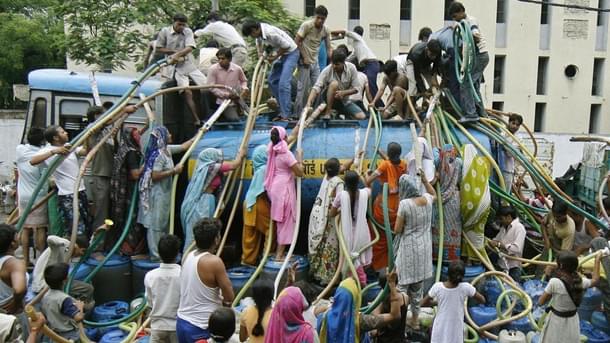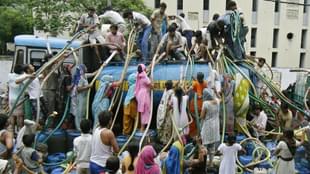Ideas
How Delhi Can Move Towards A Water-Secure Future
Ekta Chauhan
Mar 06, 2018, 04:22 PM | Updated 04:22 PM IST
Save & read from anywhere!
Bookmark stories for easy access on any device or the Swarajya app.


New Delhi, the capital of the country, is home to about 17 million people. It is the largest Indian city in terms of area, and has the highest population density in the country. While according to the census, 83 per cent of the population used treated tap water as a primary potable water source, this supply is highly erratic in terms of quantity as well as quality.
The Delhi Jal Board (DJB) is the public water utility for the city and is responsible for the production and distribution of drinking water in the National Capital Territory (NCT) of Delhi. DJB says it covers about 82 per cent of households in Delhi through pipe water supply, and ensures an average availability of 50 gallons per capita per day of filtered water. Water is supplied to over 17 million people in Delhi through a water supply network comprising 11,350 km pipelines and 105 underground reservoirs for a rationalised distribution. Delhi uses an average of 835 million gallons per day (MGD) of raw water from a supply of about 906 MGD (as of 2014). It is projected that in 2021, Delhi will need a minimum of at least 1, 174 million gallons of water a day.
This water supply is, however, not uniform and varies highly across settlements. According to a study by Safe Water Network and US Agency for International Development (USAID), availability of independent water supply at households living in planned colonies is reported at 78 per cent compared to just 51 per cent in slums. This would mean a number of slum households would have to depend on shared water sources in addition to depending water tankers in case water supply failure. This results in the households not only incurring major expenses for buying water but also running the risk of contamination. Some households might also use bore wells, but that again is highly polluted.
Understanding The Problem
The problem of water supply in Delhi can be understood through three broad lenses:
Quantity
While demand for water is continuously increasing, the availability is going down with depleting water table, drying of river Yamuna and supply leakages. The districts in south and southwest of Delhi are the worst affected with lowering ground water levels (below 20-30 metres from the ground level). DJB estimates a distribution loss of around 40 per cent of the total water supplied from leakages alone.
Quality
Poor quality of drinking water emerges as a major issue for Delhi, with high levels of toxins reported in groundwater as well as the Yamuna river. About 55 per cent of the city's 15 million people are connected to the city's sewer system and its treatment plants, but because of corrosion and clogging in the system, many treatment plants do not run at full capacity. This has resulted in waste from 1,500 unplanned neighbourhoods running straight into the Yamuna. A total of 18 drains in Delhi, whose water flows into the Yamuna, are responsible for 80 per cent of pollution in the river.
Tariff And Revenue
Raising resources to invest in the water sector is of crucial importance. DJB has incurred huge revenue losses in the past due to unmetered connections, which constituted about 20 per cent of the total connections in 2011- 12. DJB also pays for subsidy of poor consumers using up to 20 kilolitres of water per month and provides free connections to those using up to 6 kilolitres per month.
Moving Towards A Water Secure Future
Even today, Delhi lacks a comprehensive water policy. While DJB is the organisation with the largest mandate in Delhi’s water sector, it does not have a sole and exclusive mandate. Thus, what is required is a medium and long term vision for the city’s water requirements that can address the following concerns:
- Complete water security to all households even during times of poor water flow or flux. In case of shortage, water supply must be prioritised among various sectors.
- Water policies need to be in sync with climate change. As the water flow in river Yamuna varies greatly and this trend is likely to continue, a sustainable policy for groundwater and waste water usage needs to be designed and that which can supplement the river water.
- Waste water management is another area that has been hitherto ignored by policy makers. Policies need to support and incentivise treatment and usage of waste water especially by water intensive commercial units. Industries, power plants, large scale users in the transport sector should use recycled water as much as possible.
- Further, treatment technology of existing sewer treatment plants (STPs) should be improved. The National Water Policy (2002) has set 15 per cent losses in the distribution system as an acceptable norm. Currently, the rate of loss in water distribution in Delhi is claimed to be 30 per cent. Some cities like Singapore and Paris have lowered their distribution losses to 5 per cent. So, there is a need for more efficient systems to minimise losses due to system failure as well as illegal connections.
- There is an urgent need to set up an integrated water regulation authority. Currently, bodies in charge of water supply, sewer management, river water, groundwater, water harvesting work under fragmented jurisdictions, making it difficult to take a fully coordinated approach on water issues. An integrated body comprising various cells can streamline operations.
While administrative and policy changes are required, the citizens have to act on the problems and rationalise their demands. Water, is an essential commodity, but is barely regarded as precious. The public at large remains ill-informed and water illiterate about the city’s water resources and constraints. Citizens, being the largest stakeholders, need to play their part in securing a sustainable future and can, perhaps, begin by conserving water in their own homes and making a move towards rain water harvesting.
Ekta is a staff writer at Swarajya.





